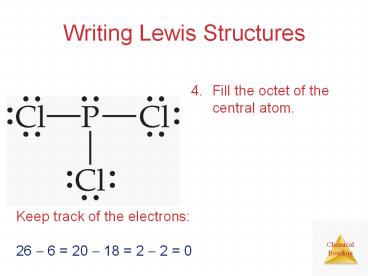Writing Lewis Structures - PowerPoint PPT Presentation
1 / 25
Title:
Writing Lewis Structures
Description:
Writing Lewis Structures Fill the octet of the central atom. Keep track of the electrons: 26 6 = 20 18 = 2 2 = 0 Writing Lewis Structures If you run out of ... – PowerPoint PPT presentation
Number of Views:1133
Avg rating:3.0/5.0
Title: Writing Lewis Structures
1
Writing Lewis Structures
- Fill the octet of the central atom.
Keep track of the electrons 26 ? 6 20 ? 18
2 ? 2 0
2
Writing Lewis Structures
- If you run out of electrons before the central
atom has an octet - form multiple bonds until it does.
3
Writing Lewis Structures
- Then assign formal charges.
- For each atom, count the electrons in lone pairs
and half the electrons it shares with other
atoms. - Subtract that from the number of valence
electrons for that atom The difference is its
formal charge.
4
Writing Lewis Structures
- The best Lewis structure
- is the one with the fewest charges.
- puts a negative charge on the most
electronegative atom.
5
Resonance
- This is the Lewis structure we would draw for
ozone, O3.
-
6
Resonance
- But this is at odds with the true, observed
structure of ozone, in which - both OO bonds are the same length.
- both outer oxygens have a charge of ?1/2.
7
Resonance
- One Lewis structure cannot accurately depict a
molecule such as ozone. - We use multiple structures, resonance structures,
to describe the molecule.
8
Resonance
- Just as green is a synthesis of blue and yellow
- ozone is a synthesis of these two resonance
structures.
9
Resonance
- In truth, the electrons that form the second CO
bond in the double bonds below do not always sit
between that C and that O, but rather can move
among the two oxygens and the carbon. - They are not localized, but rather are
delocalized.
10
Resonance
- The organic compound benzene, C6H6, has two
resonance structures. - It is commonly depicted as a hexagon with a
circle inside to signify the delocalized
electrons in the ring.
11
Exceptions to the Octet Rule
- There are three types of ions or molecules that
do not follow the octet rule - Ions or molecules with an odd number of
electrons. - Ions or molecules with less than an octet.
- Ions or molecules with more than eight valence
electrons (an expanded octet).
12
Odd Number of Electrons
- Though relatively rare and usually quite
unstable and reactive, there are ions and
molecules with an odd number of electrons.
13
Fewer Than Eight Electrons
- Consider BF3
- Giving boron a filled octet places a negative
charge on the boron and a positive charge on
fluorine. - This would not be an accurate picture of the
distribution of electrons in BF3.
14
Fewer Than Eight Electrons
- Therefore, structures that put a double bond
between boron and fluorine are much less
important than the one that leaves boron with
only 6 valence electrons.
15
Fewer Than Eight Electrons
- The lesson is If filling the octet of the
central atom results in a negative charge on the
central atom and a positive charge on the more
electronegative outer atom, dont fill the octet
of the central atom.
16
More Than Eight Electrons
- The only way PCl5 can exist is if phosphorus has
10 electrons around it. - It is allowed to expand the octet of atoms on the
3rd row or below. - Presumably d orbitals in these atoms participate
in bonding.
17
More Than Eight Electrons
- Even though we can draw a Lewis structure for the
phosphate ion that has only 8 electrons around
the central phosphorus, the better structure puts
a double bond between the phosphorus and one of
the oxygens.
18
More Than Eight Electrons
- This eliminates the charge on the phosphorus and
the charge on one of the oxygens. - The lesson is When the central atom is on the
3rd row or below and expanding its octet
eliminates some formal charges, do so.
19
Covalent Bond Strength
- Most simply, the strength of a bond is measured
by determining how much energy is required to
break the bond. - This is the bond enthalpy.
- The bond enthalpy for a ClCl bond,
- D(ClCl), is measured to be 242 kJ/mol.
20
Average Bond Enthalpies
- This table lists the average bond enthalpies for
many different types of bonds. - Average bond enthalpies are positive, because
bond breaking is an endothermic process.
21
Average Bond Enthalpies
- NOTE These are average bond enthalpies, not
absolute bond enthalpies the CH bonds in
methane, CH4, will be a bit different than the - CH bond in chloroform, CHCl3.
22
Enthalpies of Reaction
- Yet another way to estimate ?H for a reaction is
to compare the bond enthalpies of bonds broken to
the bond enthalpies of the new bonds formed.
- In other words,
- ?Hrxn ?(bond enthalpies of bonds broken) ?
- ?(bond enthalpies of bonds formed)
23
Enthalpies of Reaction
- CH4(g) Cl2(g) ???
- CH3Cl(g) HCl(g)
- In this example, one
- CH bond and one
- ClCl bond are broken one CCl and one HCl bond
are formed.
24
Enthalpies of Reaction
- So,
- ?Hrxn D(CH) D(ClCl) ? D(CCl) D(HCl)
- (413 kJ) (242 kJ) ? (328 kJ) (431 kJ)
- (655 kJ) ? (759 kJ)
- ?104 kJ
25
Bond Enthalpy and Bond Length
- We can also measure an average bond length for
different bond types. - As the number of bonds between two atoms
increases, the bond length decreases.































